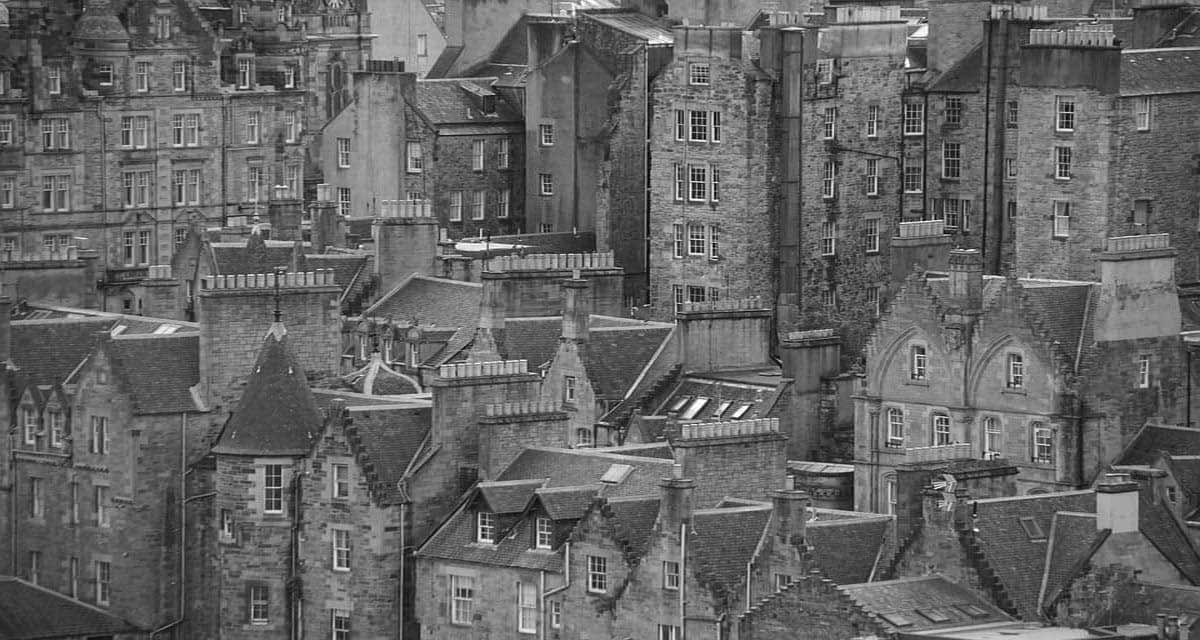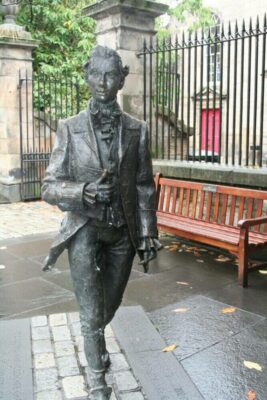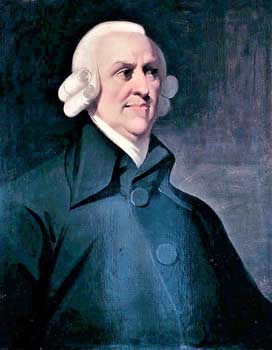
Edinburgh convivial clubs, during the 18th century, were essentially gatherings of like-minded individuals.
They came together on regular occasions to engage in discussion and debate on a wide range of topics while enjoying the ‘social experience’.
This post on Truly Edinburgh gives an overview of some of the clubs and societies that played a vital role in shaping the city’s intellectual, cultural, and social landscape during the Enlightenment era.
Often meeting in one of Edinburgh’s Old Town’s many taverns, the clubs provided a platform for prominent thinkers, writers, and socialites to come together.
This allowed the members to engage in lively discussions and sharing of ideas on a wide range of scholarly topics. In essence, a gentlemen’s intellectual exchange.
The enjoyment of food, drink, and entertainment was an important part of the ritual.
Those who took part were usually men from the higher social groups
They were often considered to be Edinburgh’s literati, although that was not always the case. The Poker Club, for example, listed merchants and military men among its members.
Initially, ladies were not allowed to participate. It was towards the end of the century before they were given what might be called observer status. This meant that they could attend but were not allowed to contribute to the discussion.
Edinburgh convivial clubs: drinking and thinking establishments
Certainly, dining and drinking, often to excess, was an important part of the ritual. Mario Relich, writing in Serendipitous Edinburgh called the meetings “well lubricated occasions” Corey E Andrews considered the venues “Drinking and Thinking” establishments.
The clubs played an important role in the social and intellectual life of the city. They helped to foster a sense of community while promoting the ideals of the Scottish Enlightenment, a remarkable period of intellectual and cultural flowering in Scotland.
However, in a myriad of 18th century Edinburgh clubs and learned societies, not all included that ‘extra conviviality’ in their meetings.
Some of the most notable Edinburgh convivial clubs included:
1)The Crochallan Fencibles
The Crochallan Fencibles, perhaps the best known of all the Edinburgh convivial clubs, met in Daniel (“Dawney”) Douglas’s tavern on Anchor Close, a public house off the High Street (part of the Royal Mile).
A group of friends, including the printer William Smellie, and the lawyer William Dunbar founded the club in 1776.
- On a side note, for those particularly interested in William Smellie’s life his correspondence and manuscripts and held in the library of the National Museum of Scotland.
The club’s name was a joke, as it was not a real military unit. The members were known for their wit and their love of good food and drink. They met regularly to eat, drink, and talk about literature, politics, and current events.
Some of the most famous members of the Crochallan Fencibles included:
- William Smellie (1740-1795): A printer and publisher, Smellie was the founder of the Crochallan Fencibles and the editor of the first edition of the Encyclopædia Britannica,
- William Dunbar (1750-1790): A lawyer and poet, Dunbar was known for his wit and his love of satire. He was a close friend of Burns and introduced him to the works of Spencer.
- Robert Burns (1759-1796): The most famous member of the club was a poet and lyricist. He was a regular visitor to the Crochallan Fencibles and his poems were often inspired by the company he kept there.
- John Clerk of Eldin (1757-1832): A lawyer and naval historian, Clerk was a friend of Burns and a member of the Crochallan Fencibles. He was known for his wit and his love of good food and drink.
- James Burnet, Lord Monboddo (1714-1799): A judge and philosopher, Monboddo was known for his eccentric ideas about the evolution of humans from apes. He was a member of the Crochallan Fencibles and a friend of Burns.
- The Crochallan Fencibles disbanded in the early 19th century, but its legacy lives on. The club is remembered as a place where some of Scotland’s greatest writers and thinkers met to share their ideas and enjoy each other’s company.
2) Edinburgh Convivial Club
The Edinburgh Convivial Club was a social club founded in Edinburgh in 1762. The club was founded by a group of lawyers and judges, and its membership was restricted to men of high social status.
The club met weekly to eat, drink, and play cards. The club was known for its wit and its lively debates.
The club’s meetings were held at the White Horse Tavern on the Canongate part of what is now the Royal Mile. The tavern was a popular meeting place for Edinburgh’s elite, and it was known for its good food and its lively atmosphere.
The club’s motto was “Vive la bagatelle” (“Long live trifles”). This motto reflected the club’s commitment to enjoying the simple things in life, such as good food, good drink, and good company.
Some of the most famous members of the Edinburgh Convivial Club included:
- Henry Home, Lord Kames (1696-1782): A judge and philosopher, Kames was one of the leading figures of the Scottish Enlightenment.
- James Boswell (1740-1795): A biographer and diarist, Boswell was a friend of Samuel Johnson and a frequent visitor to the Edinburgh Convivial Club.
- John Home (1722-1808): A playwright, Home was the author of the play Douglas, which was one of the most popular plays of the Scottish Enlightenment.
- Alexander Wedderburn, 1st Earl of Rosslyn (1733-1805): A lawyer and politician, Wedderburn was the Lord Chancellor of Great Britain from 1793 to 1801.
- Robert Dundas, 2nd Viscount Melville (1731-1800): A lawyer and politician, Dundas was the Lord Advocate of Scotland from 1778 to 1800.
The Edinburgh Convivial Club disbanded in the early 19th century, but its legacy lives on. The club is remembered as a place where some of Scotland’s greatest thinkers and writers met to share their ideas and enjoy each other’s company.
3) The Select Society
The Select Society was founded in 1754 by a group of Edinburgh literati, including David Hume, Adam Smith, and William Robertson. The club’s stated purpose was “to promote the improvement of taste and the cultivation of polite literature.”
Members of the Select Society automatically became members of the
was set up by the Select Society in 1755 but became an independent organisation with its own officers, meetings, and subjects for debate. All members of the Select Society were automatically members of the Edinburgh Society for the Encouragement of Arts, Sciences, Manufactures and Agriculture
4) The Poker Club
The Poker Club was founded in 1762 by a group of Edinburgh lawyers and judges. The club’s motto was “Vive la bagatelle” (“Long live trifles”), and its members were known for their wit and their love of good food and drink.
The Poker Club was a social club that was founded in 1762 in Edinburgh. It was established by a group of Scottish Enlightenment figures, intellectuals, and men of influence.
The club was initially formed to promote the establishment of a militia in Scotland following the Jacobite uprisings. However, it quickly evolved into a forum where political and intellectual matters were discussed.
Despite its name, the club had nothing to do with the game of poker; the term “poker” was intended metaphorically, suggesting that the members wanted to “poke” or stir up discussion on important issues of the day.
The membership roster of the Poker Club included some of the most eminent figures of the Scottish Enlightenment, although the full list of members is not easily accessible. However, some of the prominent members known to history include:
- Adam Smith: Economist and author of “The Wealth of Nations”
- David Hume: Philosopher and historian
- Adam Ferguson: Philosopher and historian
- John Home: Dramatist
- William Robertson: Historian and Principal of the University of Edinburgh
- Lord Elibank (Patrick Murray): A key organizer of the club
- Henry Dundas: Later became a significant political figure
- John Clerk of Eldin: Notable for contributions to naval tactics.
These men were influential in their respective fields and contributed significantly to the intellectual climate of the time. The club ceased to meet after a few years but left an indelible mark on the Scottish Enlightenment.
5) The Cape Club
The Cape Club was founded in 1730 by a group of Edinburgh merchants and tradesmen. The club’s motto was “Wealth, mirth, and good fellowship,” and its members were known for their raucous celebrations.

Some of the best-known members of the Cape Club included:
- Robert Fergusson: poet and inspiration to Robert Burns.
- William Brodie (Deacon Brodie): a cabinet maker turned burglar.
- Sir Henry Raeburn: artist.
Remarkably the club, now known as the Edinburgh Cape Society still exists today.
6) The Oyster Club
A number of prominent Scottish Enlightenment figures established the Oyster Club c. 1770.
Among them were the geologist James Hutton, chemist Joseph Black and economist and philosopher Adam Smith.

The Oyster Club met regularly at a venue, of dubious reputation, on Niddrie Street South which lies below the South Bridge for dining and conversation on the important topics of the day.
John Playfair in his biography of Hutton notes that the venue for the Oyster Club was “… one of the most disreputable houses in the city.”
Alongside the trio of Edinburgh literati, it seems that visiting thinkers were also invited.
Some sources suggest James Watt and Benjamin Franklin took part in discussions. Other members were described as “savants, manufacturers and entrepreneurs.”
“…round them was soon formed a knot of those who knew how to value the familiar and social converse of these illustrious men’ and that Hutton used to ‘regularly unbend himself with a few friends in the little society…known by the name of the Oyster Club.”
John Playfair
7) The Beggar’s Benison
The Beggar’s Benison started life in Anstruther, Fife but as it grew it opened in other Scottish cities including Edinburgh.
Founded in 1737, It was a club for Edinburgh gentlemen with a bawdy sense of humour. The members met monthly to eat, drink, and sing bawdy songs. The club was known for its wild parties.
“Professor David Stevenson described it not as an Edinburgh convivial club but more of “a club for men of rank who wanted to celebrate sex.”
- See the further information link below.
8) The Hellfire Club
The Hellfire Club was a secret club for Edinburgh men of high society. The club was founded in 1762, perhaps originally in London and met in secret to engage in hedonistic activities. The club was known for its debauchery and other dubious practices.
Researchers will find mainly sketchy details about the club.
9) The Philosophical Society of Edinburgh
The Philosophical Society of Edinburgh developed from the Society for the Improvement of Medical Knowledge. In 1783 it became part of the Royal Society of Edinburgh.
Although not a convivial club in the same ways as others mentioned here the society played an important part in Enlightenment Edinburgh.
For those looking for more information, the National Library of Scotland: Clubs and Societies link below is a good place to start
Further information on Edinburgh’s clubs and societies
Edinburgh’s convivial clubs and societies played an important part in Enlightenment Edinburgh’s history and it will take a determined researcher to find out more.
The links listed below are a good starting point for researchers:
- National Library of Scotland: clubs and societies
- Oxford Dictionary National Biography: Poker Club, Richard B. Sher, 2013
- David Stevenson, The Beggar’s Benison: Sex Clubs of Enlightenment Scotland and their Rituals (Edinburgh University Press.)
- Edinburgh Cape Society.
- James Hutton Oyster Club.